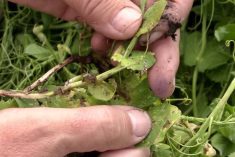CARBERRY, Man. – The jury is still out on variable rate fertilizer applications.
Alan Moulin, a soil scientist at Agriculture Canada’s research centre in Brandon, is trying to determine if the practice makes economic sense.
Working with researchers at the Manitoba Zero Tillage Research Association, Moulin began a three-year study last summer to assess the effectiveness of applying nitrogen in variable rates.
However, the data after one year remains inconclusive.
“There was a lot of variability in the results,” Moulin said during the association’s annual general meeting in Carberry March 23.
Read Also

Farmland a buyers’ market?
WINNIPEG — The farmland market in Saskatchewan may be tilting toward the buyer. It’s not there yet because sellers still…
“I wish we had more statistically significant results.”
Moulin and his colleagues devised a variable rate study with three management zones, using yield maps developed at the association’s research farm near Brookdale, Man.
“We defined high, average and low production areas,” Moulin said.
“Our hypothesis was that areas with high production would benefit from higher rates of nitrogen.”
The researchers applied zero, 50 percent, 100 percent and 150 percent nitrogen, with 100 percent representing a recommended application rate based on soil sampling and Manitoba Agriculture soil fertility guidelines.
They established test strips as wide as a seeder in canola and flax fields. The strips passed through all three management zones: high, average and low yield.
The researches applied the four rates of nitrogen in each zone.
“It’s not plot scale. It’s much bigger than plot scale,” said Moulin, who estimated certain strips were 10 acres in size.
There was only one clear result despite the size of the experiment: applying 150 percent nitrogen to high yield zones produced 34 bushels per acre of canola and 18 bu. per acre of flax. The results were several bushels per acre higher than any other combination of management zone and rate of nitrogen.
However, the yield differences between the remaining combinations were not statistically significant, which is why Moulin will repeat the experiment this summer and next.
Lindsay Coulthard, manager of the zero till association’s research farm and one of Moulin’s co-researchers, said they aren’t trying to prove variable rate works.
“We’re not trying to sell it,” said Coulthard, who estimated 10 to 15 percent of the association’s members use variable rate technology.
“It’s a question our directors are asking and want us to find out … because that’s still one of the biggest questions we’re getting from producers: does it actually pay?”
The researchers based their management zone definitions on yields rather than electrical conductivity tests because those tests aren’t accurate in Western Canada due to the region’s glaciated soil.
“If you get high conductivity, it might just be due to salts,” Moulin said.
As well, he said developing management zones according to yield is beneficial to producers.

















